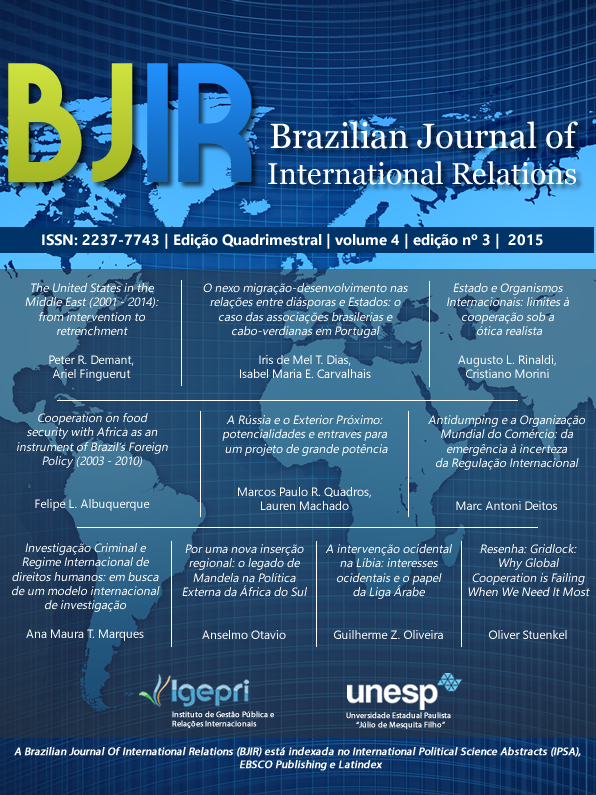The United States in the Middle East (2001–2014): from intervention to retrenchment/Os EUA no Oriente Médio (2001–2014): da intervenção ao cerceamento
DOI:
https://doi.org/10.36311/2237-7743.2015.v4n3.03.p442Resumen
The main purpose of this paper is to discuss the paradoxical consequences the so-called “Arab Spring”, from 2011 to 2014/15, which has led in various countries of the Arab world and beyond to different outcomes, but nowhere to stable democracy. We intend to discuss the outcomes of those political mobilizations and revolts, paying special attention to (a) the role of Islamist movements and (b) U.S reactions to the recent Mideast upheavals. We start with a general analysis and go to a few case studies (e.g. Egypt, Syria, and Turkey). In discussing the impact of Islamism, we attempt a classification of currents along two coordinates, one parameter contrasting Sunni and Shiite movements, the other laying out the continuum from pacific-modernist to violent jihadist. We defend that the dynamics of intra-Islamist tensions (such as Sunni jihadist against the Shiite Hizbullah-Syria-Iran axis) are no less crucial than the religious-secularist divide for understanding recent developments. Regarding US policies, we emphasize the dilemmas and contradictions within U.S government. We investigate the hypothesis that the US was caught largely unaware by the Arab Spring, and that its reactions suffered from the amorphousness of prior positions of the Obama administration, combined with leftovers from the Bush period. Internal contradictions of Obama’s Middle East doctrine coupled with a general isolationist trend have precluded the US from assuming more forceful policies, creating frustrations on all sides, and enflaming rather than dousing the fires of anti-Westernism in the Islamic world.
Keywords: Arab Spring ; U.S policies ; Syria; jihadist.
Resumo: O principal objetivo deste artigo é discutir as consequências paradoxais da chamada "Primavera Árabe", que a partir de 2011 aos nossos dias produziu em vários países do mundo árabe diferentes resultados, mas em nenhum lugar chegou-se à democracia estável. Temos a intenção de discutir os resultados dessas mobilizações políticas e revoltas, com especial atenção para (a) o papel dos movimentos islâmicos e (b) as reações e posturas dos EUA ante os recentes levantes no Oriente Médio. De uma análise geral partiremos para estudos de caso (como Egito, Síria e Turquia). Ao discutir o impacto do islamismo, tentamos uma classificação das correntes ao longo de duas coordenadas, um deles contrastando movimentos sunitas e xiitas, e outro que define o continuum de pacifista - modernista para jihadista –violento. Postulamos que a dinâmica das tensões intra- islâmicos (como a de jihadistas sunitas contra o eixo Hezbollah -Síria- Irã xiita) não são menos importantes do que a divisão religiosa - secular para compreender os desdobramentos recentes. No que diz respeito aos EUA, destacamos os dilemas e contradições dentro do governo dos EUA. Nós investigamos a hipótese de que os EUA foi pego de surpresa em grande parte pela Primavera Árabe, e que as reações do governo Obama traduzem mais um recolhimento do que um novo engajamento.
Palavras-chave: Primavera Árabe; Políticas dos EUA; Síria; jihadismo.
DOI: 10.20424/2237-7743/bjir.v4n3p442-475







